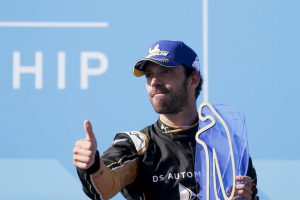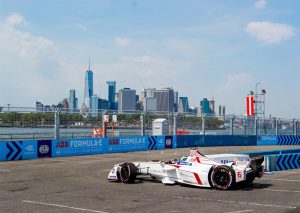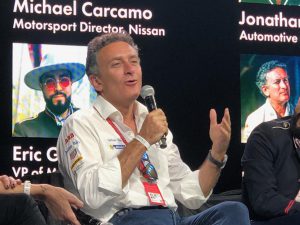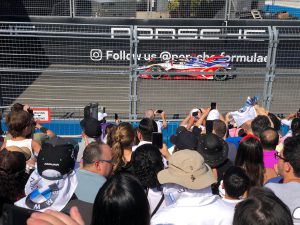
Jean-Eric Vergne, driving for the DS Techeetah team, celebrates his second season as Formula E’s world champ.
With his car rapidly running out of energy, Robin Frijns took the checkered flag to win the final race of the Formula E series on Sunday, capping a two-race weekend marking the end of the series’ fifth season – though the complicated scoring system for the world’s first global electric motorsports series meant that Jean-Eric Vergne nabbed his second consecutive season title for team DS Techeetah.
The two races were held under a blazing sun on a makeshift track in the Red Hook neighborhood of Brooklyn. But temperatures that topped 90 degrees did little to dissuade the crowds that showed up in record numbers, the event selling out weeks ahead of time, tickets for grandstand seats going for $155 apiece.
“I’m a fan of the technology,” said Bob Haddon, who had come to the race from his home in Englewood, New Jersey, along with his son Alex. “And I really like the racing. In Formula One it’s follow-the-leader. Here’s there’s more of a chance. There’s no dominant team, which makes the competition better.”
Indeed, going into the weekend, fully five teams out of 11 held out hopes they could capture the series trophy. And it wasn’t until Sunday’s finale that things were sorted out.
Like Haddon, there were plenty of fans attending the race for the first time. That reflects the dramatic growth in interest Formula E has developed over the last several years. When the program was first conceived back in 2011, there were plenty of skeptics who questioned whether it would ever stage a race. Even after the first season go underway in September 2014 in Beijing, attendance was sparse and only a handful of major automakers signed on, leaving the series largely to regional wannabes and tech firms.
But attendance isn’t the only thing growing. Jaguar signed on several years ago, a strategic move meant to help draw attention to the debut of its first all-electric model, the I-Pace. The marque now runs a support series, as well, the eTrophy.
“People can look at that and see it’s what they really can buy now,” said Kim McCullough, the U.S. marketing chief for Jaguar Land Rover.
The 2018-2019 season also marked the debut for Nissan which signed on as title sponsor with original team e.dams. Nissan driver Sebastien Buemi was one of the five drivers in contention this past weekend, rising to second in the standings after winning the first Brooklyn battle on Saturday.
“It really validates the (EV) space…seeing the growth in motor sports” Brian Maragno, the Japanese automaker’s head of electric marketing, said after the race. Despite falling short of a title win, Maragno said Nissan is “ecstatic” with its first-season results and committed to stay on for at least two more seasons.
Competition is expected to grow even tougher over the next several years. Mercedes-Benz will follow the Nissan route and partner with one of the current teams for the 2019-2020 season. There have even been reports out of England that the German automaker’s five-time F1 champion Lewis Hamilton could wind down his career by shifting to Formula E.
Ian James, the team manager of what will become the Mercedes-Benz EQ team wouldn’t discuss that possibility after the weekend’s Formula One race, but he did say he believes, “Formula E will continue to grow as a sport, as a series.”
Separately, Porsche will join in for the sixth season, creating its team, Formula E’s twelfth, from scratch.
The strong finish to season five gave Alejandro Agag, one of Formula E’s founders and its organizer, a chance to do his own victory lap over the weekend.
During a conference session on the future of motorsports technology, Agag said one of the critical moves was lining up tracks in the center of major cities, initially including places like Beijing and Rome, that attracted a new generation of race fans, many of whom relied on mass transit to get there.
“To race in New York,” said the Spanish race promoter, “was, from the beginning, one of my dreams. It’s a symbol we’re here” and have to be taken seriously.
Agag said he never wanted to create a clone of F1, and that has become more obvious this year with the debut of the second generation of Formula E cars. Though aerodynamics clearly play a role in their design, it is not quite as important as in other open wheel race programs – since speeds on FE tracks seldom get above 130 mph. That means no big wing in the back.
This year marked a critical change from a technical standpoint. For one thing, teams now can design their own drivetrains. None will discuss their approach in detail, but there are signs that one or more have even tried using two speed gearboxes. Meanwhile, the battery packs – supplied to all by McLaren Applied Technologies, jump from 24 to to 54 kilowatt-hours.
For the first four seasons, the two drivers from each team had to race hard, pit halfway through, and then jump into a second car to finish up. The new packs not only mean the cars are faster, but they can finish an entire race – though it takes careful strategizing to preserve energy along the way.
That’s not easy. Each race lasts 45 minutes plus one additional lap. And, if the lead driver crosses the finish line even a fraction of a second before the clock runs out, the entire field has to do a second lap. More than a few have run out of power before taking the checkered flag.
Complicating matters, organizers have worked a bit of social media and videogaming into the series. During each race, drivers must cross an “Activation Zone.” That gives them an additional burst of power for four minutes but also draws down their batteries more quickly. Meanwhile, the five drivers who get the most social media likes get another 45-second power boost.
Ironically, the original cars, unable to finish a full race, reinforced the concept of range anxiety, “something that has limited public acceptance of battery-electric vehicles,” said Jaguar’s McCullough. “Now, that’s taken off the table.”
As with any race series, there is clear hope, among the growing list of manufacturers turning to Formula E, that the series will help drive interest in the flood of new, all-electric vehicles coming to showrooms over the next several years. Porsche’s arrival next year will, not-so-coincidentally, be timed to coincide with the launch of its first-ever battery-electric vehicle, the Taycan.
Manufacturers have long subscribed to the mantra, “Win on Sunday, Sell on Monday.” For now, Formula E serves as an education tool for EVs, said Jaguar’s McCullough. But among the throng that gathered in Red Hook over the weekend, there was plenty of interest in the technology.
“I want to buy one,” said Veira Maiorano, a Brooklynite who had turned out for her second Formula E race. “I think it’s the way of the future.”
Husband Peter was more of a skeptic. Despite enjoying the race, he said he missed the sound of a gas engine, whether the whine of a Formula One racer or the guttural grunt of a NASCAR entry.
For his part, Agag is confident Formula E will continue winning over more fans. During the Friday technology conference, he went as far as to predict that eventually, “I think (all auto racing series) will have to go electric or they will have no relevance.”
How accurate that might prove is a matter of debate, but hybrid technology is now a norm at both Formula One and the 24 Hours of Le Mans.
It would clearly help if Formula E eventually lands a superstar like Lewis Hamilton, but if the now-completed fifth season is any indication, the program is finally getting charged up and looks to have a bright future.
(Ford, VW team up to develop electric, autonomous vehicles. Click Here for more.)



